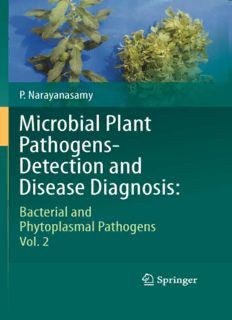
Microbial Plant Pathogens-Detection and Disease Diagnosis:: Bacterial and Phytoplasmal Pathogens, Vol.2 PDF
Preview Microbial Plant Pathogens-Detection and Disease Diagnosis:: Bacterial and Phytoplasmal Pathogens, Vol.2
Microbial Plant Pathogens-Detection and Disease Diagnosis wwww Microbial Plant Pathogens-Detection and Disease Diagnosis Bacterial and Phytoplasmal Pathogens, Volume 2 P. Narayanasamy Former Professor and Head, Department of Plant Pathology Tamil Nadu Agricultural University, Coimbatore, India P. Narayanasamy Grand Parade Apartments 32 D Thilagar Street, R. S. Puram Coimbatore 641002 India [email protected] ISBN 978-90-481-9768-2 e-ISBN 978-90-481-9769-9 DOI 10.1007/978-90-481-9769-9 Springer Dordrecht Heidelberg London New York Library of Congress Control Number: 2010938430 © Springer Science+Business Media B.V. 2011 No part of this work may be reproduced, stored in a retrieval system, or transmitted in any form or by any means, electronic, mechanical, photocopying, microfilming, recording or otherwise, without written permission from the Publisher, with the exception of any material supplied specifically for the purpose of being entered and executed on a computer system, for exclusive use by the purchaser of the work. Cover illustration: Sesamum phyllody (Volume 2) Symptoms of infection may be seen generally at the time of flowering. All floral parts are converted into green leaf-like structures. The infected plants become partially or totally sterile, depending on the time of infection. (Courtesy of B. Sreenivasulu, Tamil Nadu Agricutlural University, Coimbatore, India) Printed on acid-free paper Springer is part of Springer Science+Business Media (www.springer.com) Dedicated to the Memory of my Parents for their Love and Affection wwww Preface Existence of prokaryotes including bacteria has been recorded several billions of years ago. However, bacteria were demonstrated to be the causative agents of plant diseases only in the last quarter of the 19th century. Now numerous plant diseases are known to be due to the bacterial pathogens which induce symptoms distinct from those induced by fungal pathogens. Diseases caused by phytoplasmas were considered earlier to be due to viruses, because of the similarities in the modes of transmission of these two pathogenic groups. But visualization of plemorphic bodies without cell wall in the phloem tissues of the infected plants indicated the nature of the causative agents and provided evidence that phytoplasmas are related to bacteria and lack cell walls that are present in bacteria. As the bacteria and phytoplasmas are much smaller than the fungal pathogens, more powerful light microscopes and electron microscopes have to be employed for the detection and differentiation of these disease-causing agents. As the morphological characteristics have limited value for the differentiation of bacterial species, several biochemical tests have to be performed for the detection and identification of bacterial species causing the newly observed disease(s). The phytoplasma, on the other hand, have not been successfully cultured in cell-free media and hence, their cultural characteristics could not be studied. The biochemical tests are time-consuming, labor-intensive and often yield inconsistent results. It is essential that rapid detection and precise identification of bacteria and phytoplasmas have to be achieved within short time to assess the extent of disease incidence. In order to successfully prevent the spread of the bacterial and phytoplasmal diseases, techniques with greater sensitivity, specificity, reproducibility and rapidity have to be applied. It has been acknowledged that rapid detection and accurate identification of the microbial plant pathogens up to subspecies/strain level form the basis for the development of short- and long-term strategies for management of diseases caused by them. Immunoassays and nucleic acid-based techniques have been demonstrated to be precise and reliable, in addition to being amenable for automation and providing the results much earlier when compared with the isolation-based conventional methods. Furthermore, these modern molecular techniques have higher level of utility where the conventional methods fail to detect the pathogens in asymptomatic plants and tissues containing low concentration of bacteria and phytoplasmas. Hence, the molecular methods have become the methods of choice for the researchers in the recent years. vii viii Preface This volume presents exhaustive information based on extensive literature search on various methods of detection of bacterial and phytoplasmal pathogens and diagnosis of diseases caused by them. Comparative effectiveness of different techniques is discussed critically to enable the researchers, teachers, extension specialists and graduate students to choose the suitable techniques for their investi- gations. Further, several protocols have been presented as appendix in appropriate chapters to meet this requirement. This volume is expected to provide the necessary platform for planning more critical studies that may improve the efficiency and reliability of the existing methods that have been employed for simultaneous detec- tion of two or more kinds of pathogens, without compromising the sensitivity and specificity of detection of bacterial and phytoplasmal pathogens and diagnosis of the diseases caused by them. Coimbatore, India P. Narayanasamy Acknowledgement With a deep sense of humility, gratitude and reverence I bow to my Alma Mater that continues to remain a source of inspiration for me for over five decades. I wish to place on record appreciation to my colleagues and graduate students of the Department of Plant Pathology, Tamil Nadu Agricultural University, Coimbatore, India for their suggestions and critical comments. I am thankful to Dr. T. Ganapathy, Professor of Plant Pathology, for providing technical assistance requiring enormous patience and skill. Permission granted by different copyright holders to reproduce the figures published in various journals is gratefully acknowledged. It is with great pleasure, I thank profusely my wife Mrs. N. Rajakumari who showers her love and kindness, enabling me to devote my attention exclusively for the preparation of this book. Expression of abundant affection and endless encouragement of my family members Mr. N. Kumar Perumal, Mrs. Nirmala Suresh, Mr. T. R. Suresh and Mr. S. Varun Karthik has been the source of support for all my academic efforts during my career. ix
Description: